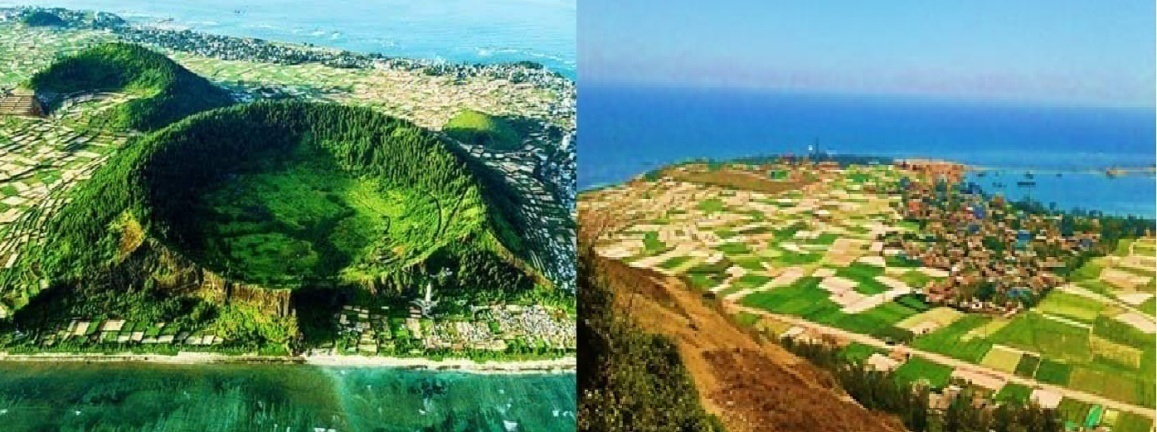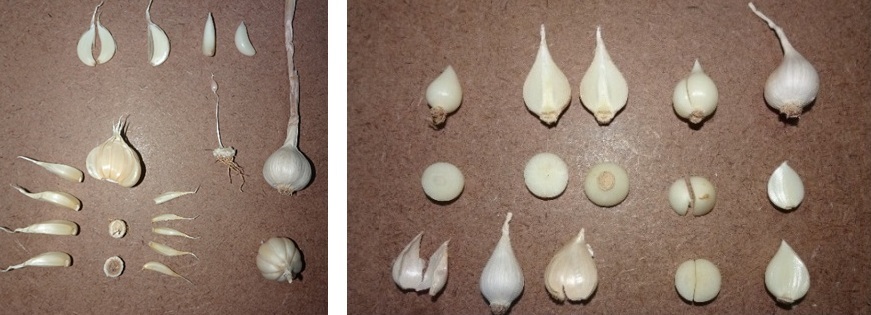Garlic is a type of spice used in culinary, and also helps fortifying the immune system, lowering blood pressure and prevent cancer. In Lý Sơn, white garlic has followed merchants from Thừa Thiên Huế to Ré island of Lý Sơn over half a century ago. Garlic production is a part of the history of Lý Sơn, the reputation of the garlic along with the beautiful scenery of the island have cemented the name “Lý Sơn” on the tourism map of Viet Nam. In 1980, the author Nguyễn Thành Long has drawn the scenery of the garlic fields on Lý Sơn island in his short story anthology “Lý Sơn in garlic season”. In 2017, Lý Sơn garlic was in the list of “Top 10 specialty of Viet Nam”. Thanks to the garlic, the people of Lý Sơn can have better lives. Therefore, they appreciate the garlic as their “white gold”.

Picture 1. The ancient volcano mouth and the garlic fields in Lý Sơn
The type of garlic cultivated in Lý Sơn is white garlic, which exhibits peculiar traits when produced in Lý Sơn. The garlic has limestone-like white colour, the pulp has the characteristic ivory-green colour, pleasant aroma. The taste is spicy and lightly sweet. The garlic here has two forms depending on the number of cloves (more than 3 cloves or 1 – 3 cloves). The smaller form with less cloves is called “Lý Sơn lonely garlic” and is rarer. Lý Sơn small garlic can be identified by the three criteria: weight, height and diameter. Bigger garlic weights 2.5 - 20 gram per bulb, the height is 18 - 35 mm the height is 15 – 37.5 mm. Lonely garlic weights 0.4 – 4.3 gram per bulb, the height is 16 - 28 mm, the height is 6.5 - 19 mm.

Picture 2: Forms of Lý Sơn garlic
The moisture of Lý Sơn garlic is 57.71 – 69.31 % of weight, total ash content is 1.41 – 2.70 % of dry matter weight, acid-insoluble ash content is 0.04 – 0.18 % of dry matter weight, vaporized organic Phosphorus compounds content is 0.14 – 0.22 % of dry matter weight, cold water-soluble extract content is 54.96 – 84.35 % of dry matter weight, Allicin content is 54,26 - 133,10 mg/kg, Potassium content is 348.0 – 371.0 mg/100g. The Potassium content and vaporized organic Phosphorus compounds content are the two chemical criteria that define the peculiar quality of Lý Sơn garlic.
The topography, climate and soil properties has resulted in the characteristics of Lý Sơn garlic. The primary terrain of Lý Sơn is low mountain on ancient volcano. The area is narrow with relatively flat surface, declining from island center to the edge with the altitude of 20 – 25 meter. Garlic is planted on staircase fields around the ancient volcano mouth, declining towards the island edge which helps with water drainage. The climate of the island is tropical monsoon of coastal plain (drought in the dry season, and storms and strong wind in the rain season). The annual average rainfall is low and highly fluctuates throughout the months (0.1 – 1,244,2 mm). The total radiation is high, with 38.0 – 334.5 hours of sunlight per month. The average temperature is 21.8°C – 30.5°C and rarely dips below 18oC. The coastal climate and temperature is suitable to the development of garlic. The soil in the geographical area has the pHH2O level of 7.79 – 8.51, pHKCL level of 7.03 – 8.13, soluble potassium content of 2.02 – 13.50 mg/100g formulated from basaltic rocks of volcano eruption. The soil combining with coral limestone rock, limestone sand, deposited dust and clay has created the peculiarity of Lý Sơn’s pedology. The basalt soil is an important resource of Lý Sơn island, being the ingredient to make Lý Sơn garlic cultivating medium.
Aside from the natural conditions, the experience and know-how of the producers also contribute to the peculiarity of Lý Sơn garlic. A majority of agricultural production area on Lý Sơn island was cultivated over 400 years ago. The process of reforming, consolidating and level the field has gradually changed to meet the biological needs of Lý Sơn garlic. Moreover, the know-hows in cultivation, soil preparation, field reform to suit the drought nature of Lý Sơn island of the farmers has become the unique agricultural practice of this land. Lý Sơn locals have the experience in choosing the season and covering the garlic field by coral sand to reduce evaporation, stabilize soil moisture, protecting the garlic roots. The fence which serves as wind cover helps mitigating the adverse effects of the sea salt in the wind to the garlic field, reducing erosion and preventing sand from getting into the field. Lý Sơn farmers call these fences the “armor” protecting garlics from climatic conditions of the island.

Picture 3. Wind fences covering the garlic fields on Lý Sơn island
Geographical area: Garlic of Lý Sơn is cultivated in the communes of An Bình, An Hải, and An Vĩnh of Lý Sơn district, Quảng Ngãi province.